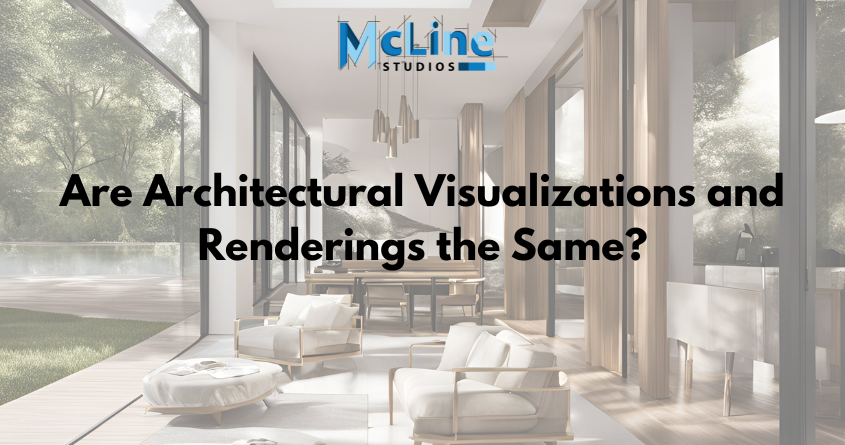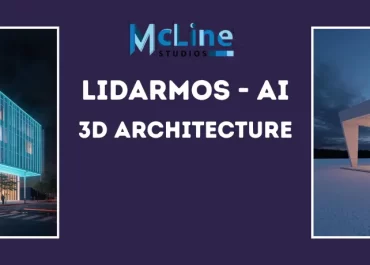Architectural visualizations and renderings are closely related but have distinct focuses and purposes. Consider architectural rendering as a subset of architectural visualization.
Architectural visualizations are like a broad picture of a design concept. They can include anything from basic sketches to highly detailed 3D models that show how a building or space will look in its surroundings.
Architectural renderings, on the other hand, are usually more focused and detailed. They provide a realistic view of specific parts of a project, like the interior of a room or the exterior facade.
Let’s understand the difference between them in detail.

What Is Architectural Visualizations?
Architectural visualizations are digital images or animations that show what a building will look like before it’s built. Using 3D modeling software, these visualizations create realistic pictures that help clients, architects, and others see the design in detail. This makes it easier to understand the layout, design, and overall feel of the project.
Architectural visualizations often include realistic elements like lighting, textures, and even landscaping, which make the building look as real as possible. These visualizations are useful for showing clients a complete view of the project and help in making design choices early on.
Unlike architectural renderings, which usually show one specific part or angle of a design, visualizations give a broader view and often include multiple perspectives. This gives everyone a clearer understanding of the whole space and helps with decision-making.
What Are Architectural Renderings?
Architectural renderings are images that show what a building or space will look like before it’s built. Architects and designers use these visuals to share their ideas with clients and help them picture the final look of the project. Renderings can range from basic sketches to realistic, computer-generated images that show details like materials, colors, lighting, and even landscaping.
These visuals are useful because they make it easier for clients to understand the design. With the help of rendering, clients can give feedback and make decisions with more confidence. Renderings also help spot any design issues early on, which can save time and money once construction starts.
Architectural Visualization vs. Architectural Rendering
| Aspect | Architectural Visualizations | Architectural Renderings |
| Purpose | Helps in visualizing the entire architectural concept. | Focuses on creating detailed images of specific elements. |
| Scope | Includes plans, layouts, and virtual tours. | Mainly covers realistic images or animations of a building. |
| Output Format | Can be interactive (e.g., 3D walkthroughs). | Usually involves images or videos. |
| Detail Level | Broad, covering the whole project’s look and feel. | Highly detailed with realistic textures and lighting. |
| Use Cases | Used for initial project presentations and client approvals. | Often used in marketing materials or final project stages. |
| Tools | Includes a mix of 3D modeling, VR, and AR tools. | Primarily uses rendering software like 3ds Max for photorealistic output. |
| Targeted Audiences | Architects, designers, and clients to understand concepts. | Generally clients, investors, and marketing teams for promotion. |
| Time Required | Generally faster to produce as it’s broader. | Takes longer due to high detail and realistic output. |
What To Choose: Visualization or Rendering?
The decision between choosing architectural visualization and rendering depends on the individual needs and stage of the project.
Architectural Visualization
- Best for Early Stages: Use visualization when you are brainstorming ideas or in the initial planning phase. It helps in understanding concepts quickly.
- Simple Representation: It includes sketches, diagrams, or basic 3D models. This simplicity aids in communicating ideas clearly without overwhelming details.
- Focus on Concepts: Ideal for presentations where you want to explain a design or concept to clients or team members without diving into intricate details.

Architectural Rendering
- Best for Final Presentation: Choose rendering when you need to present a completed design or product. This is where you want to impress with high-quality visuals.
- Realistic Images: Rendering creates lifelike images using detailed 3D models, lighting, and textures. It gives a true sense of what the final product will look like.
- Marketing and Promotion: Perfect for use in marketing materials, portfolios, or client proposals where visual appeal is important.
So, choose visualization when you need to explain concepts quickly, showcase simple ideas, or brainstorm and plan designs. On the other hand, opt for rendering when you want to present realistic visuals, highlight a completed product, or create high-quality marketing materials.
Summary
To sum it up, both architectural visualizations and renderings play important roles in the design process, but they serve different purposes. Architectural visualizations provide a broader view of a project, helping clients and architects understand the overall concept and layout, especially in the early planning stages. They use simpler representations like sketches and basic 3D models.
On the other hand, architectural renderings focus on creating detailed and realistic images of specific elements, ideal for final presentations and marketing. They showcase the finished look of a project using high-quality visuals, which help clients feel confident about their choices.
The decision of choosing between the two depends on the project’s stage and goals: use visualizations for initial ideas and brainstorming, and renderings for polished presentations and marketing materials.




